In some types of partner dance, lead and follow are designations for the two dancers' roles in a dance pairing. The leader is responsible for guiding the couple and initiating transitions to different dance steps and, in improvised dances, for choosing the dance steps to perform. The leader communicates choices to the follower, and directs the follower by means of subtle physical and visual signals, thereby allowing the pair to be smoothly coordinated.
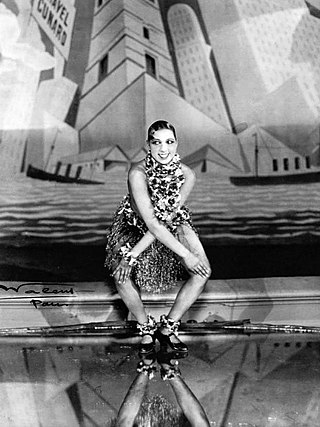
The Charleston is a dance named after the harbor city of Charleston, South Carolina. The rhythm was popularized in mainstream dance music in the United States by a 1923 tune called "The Charleston" by composer/pianist James P. Johnson, which originated in the Broadway show Runnin' Wild and became one of the most popular hits of the decade. Runnin' Wild ran from 28 October 1923, through 28 June 1924. The peak year for the Charleston as a dance by the public was mid-1926 to 1927.
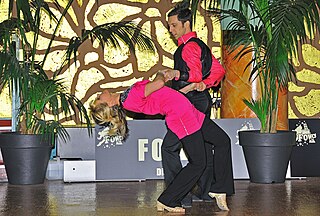
West Coast Swing is a partner dance with roots in Lindy Hop. It is characterized by an elastic look that results from its extension-compression technique of partner connection and is danced primarily in a slotted area on the dance floor. The dance allows for both partners to improvise steps while dancing together, putting West Coast Swing in a short list of dances that emphasize improvisation.

Swing dance is a group of social dances that developed with the swing style of jazz music in the 1920s–1940s, with the origins of each dance predating the popular "swing era". Hundreds of styles of swing dancing were developed; those that have survived beyond that era include Charleston, Balboa, Lindy Hop, and Collegiate Shag. Today, the best-known of these dances is the Lindy Hop, which originated in Harlem in the early 1930s. While the majority of swing dances began in African-American communities as vernacular African-American dances, some influenced swing-era dances, like Balboa, developed outside of these communities.
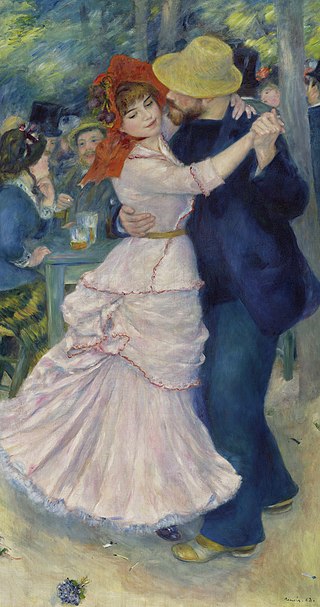
In partner dancing, closed position is a category of positions in which partners hold each other while facing at least approximately toward each other.
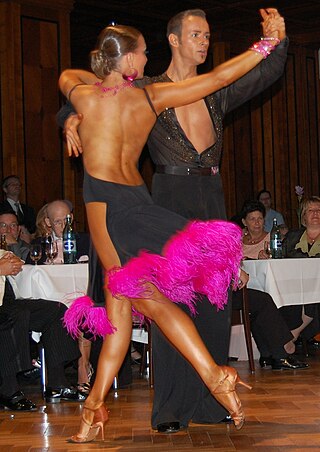
Partner dances are dances whose basic choreography involves coordinated dancing of two partners, as opposed to individuals dancing alone or individually in a non-coordinated manner, and as opposed to groups of people dancing simultaneously in a coordinated manner.

In ballroom dancing and other dances, frame is the way the dancers' upper bodies are held when in dancing position. In swing and blues dances, frame is the body shape and muscle tone maintained by dancers, which allows the leader to communicate moves to the follower.
This is a list of dance terms that are not names of dances or types of dances. See List of dances and List of dance style categories for those.
Chicken walks is a dance move that is most frequently used in swing dances, such as East Coast Swing, West Coast Swing and jive. Sometimes they can be seen incorporated in samba.
Dance improvisation is the process of spontaneously creating movement. Development of movement material is facilitated through a variety of creative explorations including body mapping through levels, shape and dynamics schema.
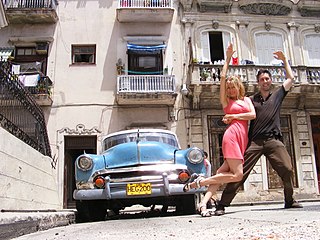
In Cuba, a popular dance known as Casino was marketed abroad as Cuban-style salsa or Salsa Cubana to distinguish it from other salsa styles when the name was popularized in the 1970s. Dancing Casino is an expression of popular social culture in Cuba and many Cubans consider casino a part of their social and cultural activities centering on their popular music.
In partner dancing, open position refers to positions in which partners are connected primarily at the hands as opposed to closer body contact, as in closed position. The connection is through the hands, wrists, and fingers, and relies heavily on frame and the compression and tension of both partners' arms.

In partner dances, close embrace is a type of closed position where the leader and follower stand facing each other chest-to-chest in full or partial body contact. The dancers usually stand offset from one another, such that each has their right foot in between the feet of their partner. When in close embrace, the dance is led with the whole body, rather than with the arms or with visual cues. Various partner dances make use of this position, most notably Argentine Tango, but also Balboa, Collegiate Shag, Swing Walk, Blues, Salsa Dance, and others.
Rock step may refer to one of several similar dance moves. The name refers to the rocking action during the move: the weight is transferred from one foot to another and then back. It is used in a number of dances, such as East Coast Swing, Zydeco, Lindy Hop, Tango.

In engineering, a mechanism is a device that transforms input forces and movement into a desired set of output forces and movement. Mechanisms generally consist of moving components which may include:
The promenade position is a dance position in ballroom and other dances. It is described differently in various dance categories.
Figures of Argentine tango are elements of Argentine tango.

Fusion dance is a type of contemporary social improvised partner dance that combines different dance styles to create a new aesthetic. It does not require conforming to any particular defined dance styles, but typically uses a lead-follow approach that emphasises musicality.
Brazilian Zouk is a partner dance which began in Brazil during the early 1990s. Brazilian Zouk evolved from the partner dance known as the Lambada. Over time, Zouk dancers have experimented and incorporated other styles of music into Zouk, such as R'n'B, pop, hip hop and contemporary.









